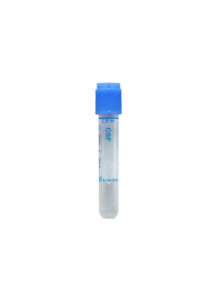Clinical Updates
New Test – Alzheimer’s Disease Biomarker Panel, Cerebrospinal Fluid
Alzheimer’s Disease Biomarker Panel, Cerebrospinal Fluid (ALZCSF) measures p-Tau181, Total-Tau, and β-Amyloid (1-42) (Abeta42).
Testing is performed on cerebrospinal fluid (CSF) from adult patients 55 years of age and older undergoing evaluation for Alzheimer’s disease and other causes of cognitive impairment to generate pTau181/Abeta42 and Total-Tau/Abeta42 ratios.
The new test requires a CSF Specimen Transport Tube and other modifications to the reporting format, which are detailed below.
Note: ADmark Phospho-Tau CSF (PHOTAU) testing, sent out to Athena, will be discontinued.
Test Overview
Test Name
Alzheimer’s Disease Biomarker Panel, Cerebrospinal Fluid
Test Code
CPT Codes
83520 – QTY (3)
Methodology
Electro Chemiluminescence Immunoassay (ECLIA)
Specimen Requirements
Type:
Cerebrospinal fluid (CSF)
Volume:
2.5 mL
Container:
CSF Transport Tube, 2.5 mL (Sarstedt)
Collection Instructions
- Confirm that the tube type is correct – only a specimen collected in the Sarstedt CSF Transport Tube [ref. 63614.625] is acceptable.
- Perform a lumbar puncture using the gravity drip collection method (preferred). Do not use the first 2 mL of CSF.
- Collect CSF directly into the tube up to the fill line.
- Inspect the sample for the presence of blood. Do not use CSF samples that appear reddish. Instead, collect additional clear (non-hemolytic) CSF in a new CSF tube.
- Do not process the sample before sending it to the laboratory (i.e., do not invert, transfer, or aliquot).

Rejection Criteria
CSF collected in polystyrene or glass tubes
Bloody or hemolyzed specimens.
Unfilled tubes.
Stability
Ambient:
5 days
Refrigerated (preferred):
14 days
Frozen:
8 weeks (-20⁰C)
Days Performed
Days Performed
Once a week
Reported
1-8 days
Reporting
Component
p-Tau181/Abeta42
Total-Tau/Abeta42
p-Tau181
Total-Tau
Abeta42
Reference Interval
≤0.0230
≤0.280
≤31.3 pg/mL
≤375.4 pg/mL
≥564.2 pg/mL
Clinical Information
A negative p-Tau181/Abeta42 ratio and/or Total-Tau/Abeta42 ratio is consistent with a negative amyloid positron emission tomography (PET) scan and reduces the likelihood that a patient’s cognitive impairment is due to Alzheimer’s disease.
A p-Tau181/Abeta42 ratio and/or Total-Tau/Abeta42 ratio elevated above the cut-off is consistent with biological changes associated with Alzheimer’s disease (AD) and a positive amyloid positron emission tomography (PET) scan. A positive result does not establish a diagnosis of AD or other cognitive disorders and should be interpreted as an adjunct to other clinical diagnostic information.
The ratios will not be calculated in samples with an Abeta42 concentration >2,500 pg/mL. This result is consistent with a negative amyloid positron emission tomography (PET) scan and reduces the likelihood that a patient’s cognitive impairment is due to Alzheimer’s disease.
The p-Tau181, Total-Tau, and Abeta42 tests are not intended to be used as a stand-alone test in spinal fluid. For interpretation of results, refer to the p-Tau181/Abeta42 and Total-Tau/Abeta42 ratios.
The test method is the Elecsys electrochemiluminescence immunoassay manufactured by Roche Diagnostics. Values determined by different assay methods cannot be used interchangeably.
The validity of this test interpretation requires strict adherence to the specimen collection and preparation instructions detailed in the Cleveland Clinic’s Test Directory.
